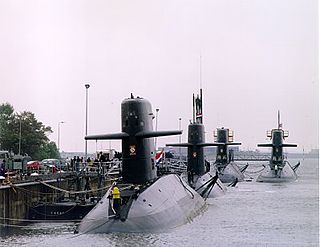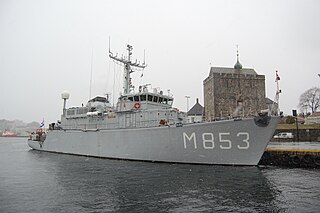The Royal Netherlands Navy is the naval force of the Kingdom of the Netherlands. It is one of the four Netherlands Armed Forces. It was founded on 8 January 1488, making it the third-oldest naval force in the world.

The Karel Doorman-class frigates are a series of eight multi-purpose vessels built for the Royal Netherlands Navy. Its namesake is Karel Doorman, a Dutch naval officer whose ship was struck by a Japanese torpedo in the battle of the Java Sea in 1942, and who, as a result of which, went down with his ship.

The Walrus-class submarine is the only submarine class currently in operation in the Royal Netherlands Navy. The boats have been in service since 1990 and are all named after sea mammals.

The De Zeven Provinciën class was a class of light cruisers. They were built by Rotterdamsche Droogdok Maatschappij (RDM) and Wilton-Fijenoord for the Royal Netherlands Navy. The name De Zeven Provinciën refers to the seven provinces which formed the Dutch Republic in 1581.

The Zwaardvis-class submarine ("Swordfish") is a class of conventional attack submarines that were built to strengthen the Royal Netherlands Navy. The Dutch government opted for the choice to not replace the two Zwaardvis-class submarines with either more Walrus-class submarines, or submarines of a new design.

The Holland-class destroyers were built for the Royal Netherlands Navy in the 1950s. They were the first major warships designed and built by the Dutch after World War II. In contrast to previous Dutch Navy practice the ships were named after provinces rather than admirals.

The Dolfijn-class submarines of the Royal Netherlands Navy are a class of four submarines; Dolfijn, Zeehond, Potvis and Tonijn. They were built in the late 1950s and the early 1960s. They were the first indigenous submarines built in the Netherlands and for the Royal Netherlands Navy after World War II. In the Netherlands they are also known as "three cylinder" submarines.

The Royal Netherlands Navy Submarine Service is a department within the Royal Netherlands Navy that is responsible for the deployment of Dutch submarines. It was established out of the Netherlands Torpedo Service on 21 December 1906, and merged with the Netherlands Mine Service on 15 July 2005.

The Alkmaar class is a ship class of fifteen minehunters that were built in the Netherlands for the Royal Netherlands Navy. They are based on the design of the Tripartite class, which was developed by a collaborative effort between the Netherlands, Belgium and France, and replaced the minesweepers and minehunters of the Dokkum class.

The Van Amstel class was a class of six frigates that were built during the Second World War in the United States and served as Cannon-class destroyer escort during that war. After the war the destroyer escorts were loaned to the Dutch navy as part of the MDAP and from 1950 to 1967 served as the Van Amstel-class frigates.

HNLMS Poolster was a replenishment ship serving with the Royal Netherlands Navy. Poolster entered service on 29 June 1964. In 1994 she was decommissioned and sold to the Pakistan Navy where the ship was renamed Moawin. A later replenishment ship Zuiderkruis was based on Poolster. In the Dutch navy she was replaced by the replenishment ship Amsterdam. She was the first ship in the Dutch navy with inbuilt protection against radioactive fallout.

HNLMS Holland (D808) was the lead ship of her class of four destroyers built for the Royal Netherlands Navy in the early 1950s. HNLMS Holland is named after a former province of the Kingdom of the Netherlands and was the twentieth ship with this name. In 1978 the ship was taken out of service and sold to Peru where it was renamed Garcia y Garcia. The ship's radio call sign was "PAOP".

HNLMS Zeeland (D809) was a destroyer of the Holland class. The ship was in service with the Royal Netherlands Navy from 1955 to 1979. The destroyer was named after the Dutch province of Zeeland and was the twenty-first ship with this name. In 1978 the ship was taken out of service and later broken up and scrapped. The ship's radio call sign was "PAAU".

HNLMS Noord-Brabant (D810) was a Holland-class anti-submarine destroyer of the Royal Netherlands Navy. The ship was from 1955 to 1974 in Dutch service. On 9 January 1974, HNLMS Noord-Brabant was rammed amidships by an English merchant ship. The damage was estimated to be expensive so the Royal Netherlands Navy decided to not repair the damage but instead decommission the ship earlier than planned. The ship's radio call sign was "PAIP".

HNLMS Gelderland (D811) was a destroyer of the Holland class. The ship was in service with the Royal Netherlands Navy from 1955 to 1973. The destroyer was named after the Dutch province of Gelderland and was the twenty-first ship with this name. In 1973 the ship was taken out of service, after which it was given a berth in Amsterdam for the Technical Training Royal Navy (TOKM) school. During her service the ship's radio call sign was "PARY". The ship was sold for scrapping in 1988.

The Roofdier class was a class of six frigates that were built in the United States as Patrol Craft Escorts (PCE) for the Netherlands. The frigates were loaned to the Royal Netherlands Navy as part of the Mutual Defense Assistance Act (MDAP) and from 1954 to 1984 served as the Roofdier-class frigates.

HNLMS Friesland (D812) was a destroyer of the Friesland class. The ship was in service with the Royal Netherlands Navy from 1956 to 1979. The destroyer was named after the Dutch province of Friesland and was the fourteenth ship with this name. In 1979 the ship was taken out of service and later broken up. The ship's radio call sign was "PAJF".

HNLMS Utrecht (D817) was a destroyer of the Friesland class. The ship was in service with the Royal Netherlands Navy from 1957 to 1980. The destroyer was named after the Dutch province of Utrecht and was the eighteenth ship with this name. In 1980 the ship was taken out of service and sold to Peru where it was renamed Castilla. The ship's radio call sign was "PAEY".

HNLMS Amsterdam (D819) was a destroyer of the Friesland class. The ship was in service with the Royal Netherlands Navy from 1957 to 1980. The destroyer was named after the Dutch city of Amsterdam and was the nineteenth ship with this name. In 1980, the ship was taken out of service and sold to Peru, where it was renamed Villar. The ship's radio call sign was "PABH".
In April 2018, the Dutch Government approved a multi-year investment program for the Dutch Navy and allocated funds for the 2018–2030 period. The Dutch Defence Materiel Administration (DMO) is in charge of the procurement of these new ships.



















